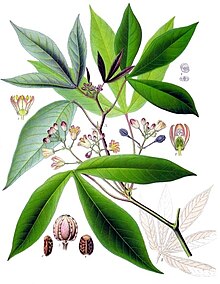कसावा
| कसावा Cassava | |
|---|---|

| |
| कसावा के पत्ते | |
| चित्र:Manihot esculenta 00001.jpg | |
| कसावा की कन्द | |
| वैज्ञानिक वर्गीकरण | |
| जगत: | पादप |
| अश्रेणीत: | सपुष्पक (Angiosperms) |
| अश्रेणीत: | युडिकॉट (Eudicots) |
| अश्रेणीत: | रोज़िड (Rosids) |
| गण: | मालपिग्यालेस (Malpighiales) |
| कुल: | युफ़ोर्बीएसी (Euphorbiaceae) |
| उपकुल: | क्रोटोनोइडेयाए (Crotonoideae) |
| वंश समूह: | मैनिहोटेआए (Manihoteae) |
| वंश: | Manihot |
| जाति: | M. esculenta |
| द्विपद नाम | |
| Manihot esculenta क्रान्ट्ज़ | |
कसावा (cassava) पृथ्वी के उष्णकटिबंधीय और उप-उष्णकटिबंधीय क्षेत्रों में उगाया जाने वाला एक क्षुप है जिसकी मोटी जड़ आलू की तरह मंड (स्टार्च) से युक्त होती है। चावल और मक्के के बाद, मानव-आहार में यह यह विश्व में तीसरा सबसे बड़ा कार्बोहाइड्रेट का स्रोत है। कसावा मूल-रूप से दक्षिण अमेरिका का वनस्पति था लेकिन अब विश्व-भर के गरम क्षेत्रों में मिलता है। जब इसको पीसकर पाउडर या मोती-आकार के कणों में बनाया जाय तो यह टैपियोका (tapioca) भी कहलाता है। कसावा सूखे की परिस्थिति में और कम-ऊपजाऊ धरती पर भी उग सकने वाला पौधा है।[1][2][3]
कसावा मीठी और कड़वी नसलों में मिलता है। अन्य कन्द-जड़ों की तरह इसमें भी कुछ वषैले पदार्थ उपस्थित होते है, जिनकी मात्रा कड़वी नसलों में मीठी नसलों से कई अधिक होती है।[4] खाने से पहले इसे सही प्रकार से तैयार करना आवश्यक है वरना इससे साइनाइड विष-प्रभाव हो सकता है, जिससे घेंघा रोग, गतिभंग और लकवा होने की सम्भावना है।[5][6] कुछ क्षेत्रों में किसान कड़वी नसलों को उगाना पसंद करते हैं क्योंकि नाशीजीव और पशु उन्हें खाना पसंद नहीं करते और उनके फ़सलों की चोरी भी कम होती है।[7][8]
इन्हें भी देखें
[संपादित करें]सन्दर्भ
[संपादित करें]- ↑ "Cassava". Food and Agriculture Organization of the United Nations. मूल से 18 नवंबर 2016 को पुरालेखित. अभिगमन तिथि 13 दिसंबर 2016.
- ↑ Fauquet Claude; Fargette Denis (1990). "African Cassava Mosaic Virus: Etiology, Epidemiology, and Control" (PDF). Plant Disease. 74 (6): 404–11. डीओआइ:10.1094/pd-74-0404. मूल (PDF) से 9 अगस्त 2017 को पुरालेखित. अभिगमन तिथि 13 दिसंबर 2016.
- ↑ "Dimensions of Need: An atlas of food and agriculture". Food and Agriculture Organization of the United Nations. 1995. मूल से 24 नवंबर 2016 को पुरालेखित. अभिगमन तिथि 13 दिसंबर 2016.
- ↑ Food and Agriculture Organization of the United Nations, "Roots, tubers, plantains and bananas in human nutrition", Rome, 1990, Ch. 7 "Toxic substances and antinutritional factors", third paragraph. Document available online at http://www.fao.org/docrep/t0207e/T0207E00.htm#Contents Archived 2016-11-21 at the वेबैक मशीन. Ch. 7 appears at http://www.fao.org/docrep/t0207e/T0207E08.htm#Cassava%20toxicity Archived 2016-11-24 at the वेबैक मशीन. (Accessed 25 June 2011.)
- ↑ "Cassava poisoning was integral to Episode 177 of Series 17 of the BBC drama 'Doctors'". BBC. 5 February 2016. मूल से 8 फ़रवरी 2016 को पुरालेखित. अभिगमन तिथि 13 दिसंबर 2016.
- ↑ Food and Agriculture Organization of the United Nations, Roots, tubers, plantains and bananas in human nutrition, Rome, 1990, Ch. 7 "Toxic substances and antinutritional factors". Document available online at http://www.fao.org/docrep/t0207e/T0207E00.htm#Contents Archived 2016-11-21 at the वेबैक मशीन. Ch. 7 appears at http://www.fao.org/docrep/t0207e/T0207E08.htm#Cassava%20toxicity Archived 2016-11-24 at the वेबैक मशीन. (Accessed 25 June 2011.)
- ↑ Food and Agriculture Organization of the United Nations, Roots, tubers, plantains and bananas in human nutrition, Rome, 1990, Ch. 7 "Toxic substances and antinutritional factors" (under "Epidemic spastic paraparesis"). Document available online at http://www.fao.org/docrep/t0207e/T0207E00.htm#Contents Archived 2016-11-21 at the वेबैक मशीन. Ch. 7 appears at http://www.fao.org/docrep/t0207e/T0207E08.htm#Cassava%20toxicity Archived 2016-11-24 at the वेबैक मशीन. (Accessed 25 June 2011.
- ↑ Linley Chiwona-Karltun, Chrissie Katundu, James Ngoma, Felistus Chipungu, Jonathan Mkumbira, Sidney Simukoko, Janice Jiggins (2002) "Bitter cassava and women: an intriguing response to food security", LEISA Magazine, volume 18 Issue 4. Online version Archived 2012-03-15 at the वेबैक मशीन accessed on 2009-08-11.
Text is available under the CC BY-SA 4.0 license; additional terms may apply.
Images, videos and audio are available under their respective licenses.
